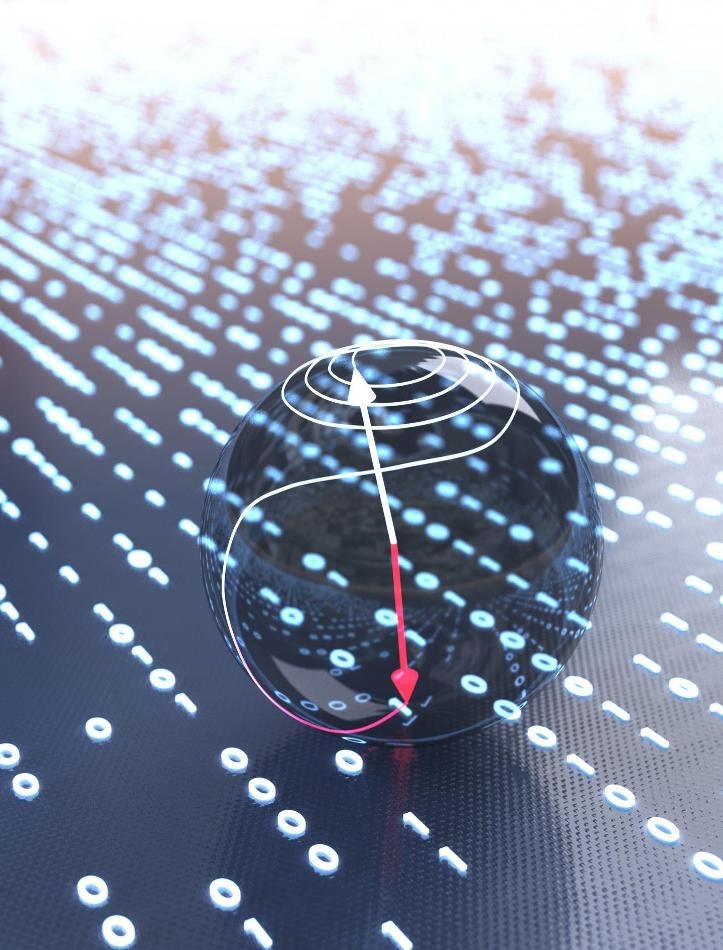May 16 2019
Superfast data processing using light pulses rather than electricity has been developed by researchers.
 Using ultrashort pulses of light enables extremely economical switching of a magnet from one stable orientation (red arrow) to another (white arrow). This concept enables ultrafast information storage with unprecedented energy efficiency. (Image credit: ©Brad Baxley (parttowhole.com))
Using ultrashort pulses of light enables extremely economical switching of a magnet from one stable orientation (red arrow) to another (white arrow). This concept enables ultrafast information storage with unprecedented energy efficiency. (Image credit: ©Brad Baxley (parttowhole.com))
The invention makes use of magnets to record computer data which consume nearly zero energy, solving the dilemma of how to produce faster data processing speeds without the associated high energy costs.
Present-day data center servers consume between 2 to 5% of global electricity consumption, generating heat which consecutively requires additional power to cool the servers.
The problem is so severe that Microsoft has even submerged several of its data center services in the ocean in an attempt to keep them cool and lower costs.
A lot of data are encoded as binary information (0 or 1, respectively) through the orientation of miniature magnets, known as spins, in magnetic hard-drives. The magnetic read/write head is used to set or recover information using electrical currents which disperse large amounts of energy.
Currently, an international team publishing in Nature has solved the issue by substituting electricity with very short pulses of light—the duration of one trillionth of a second—concentrated by extraordinary antennas on top of a magnet.
This new technique is superfast but highly energy efficient that the temperature of the magnet does not surge at all.
The team comprises of Dr Rostislav Mikhaylovskiy, formerly at Radboud University and now Lancaster University, Stefan Schlauderer, Dr Christoph Lange and Professor Rupert Huber from Regensburg University, Professor Alexey Kimel from Radboud University and Professor Anatoly Zvezdin from the Russian Academy of Sciences.
They showed this new technique by pulsing a magnet with ultrashort light bursts (the duration of a millionth of a millionth of a second) at frequencies in the far infrared, the supposed terahertz spectral range.
However, even the strongest prevailing sources of the terahertz light did not give adequately strong pulses to switch the orientation of a magnet thus far.
The innovation was realized by exploiting the efficient interaction mechanism of coupling between spins and terahertz electric field, which was found by the same team.
The researchers then designed and fabricated a tiny antenna on top of the magnet to concentrate and thereby improve the electric field of light. This strongest local electric field was adequate to steer the magnetization of the magnet to its new orientation in merely one trillionth of a second.
The magnet’s temperature did not surge at all as this process requires energy of just one quantum of the terahertz light—a photon—per spin.
The record-low energy loss makes this approach scalable. Future storage devices would also exploit the excellent spatial definition of antenna structures enabling practical magnetic memories with simultaneously maximal energy efficiency and speed.
Dr Rostislav Mikhaylovskiy, Professor, Lancaster University
He plans to conduct further research using the new ultrafast laser at Lancaster University along with accelerators at the Cockroft Institute which are able to produce strong pulses of light to enable switching magnets and to establish the fundamental and practical speed and energy limits of magnetic recording.